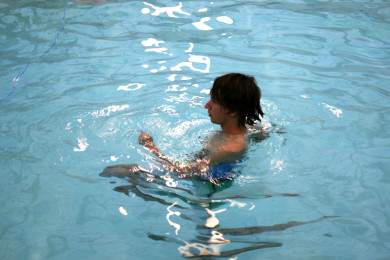As any athlete that has been injured can tell you, finding ways to stay fit while you recover can be difficult. Recently, SDA athletes have turned to aqua jogging to solve their problems. When a crippling case of shin splints hit me two weeks into the track season, senior, and fellow injured runner, Emily Nathan invited me to join her at the local YMCA.
For the uninitiated, aqua jogging involves attaching a fanny-pack-like “flotation belt” to your waist and imitating the movement of regular, non-aquatic, jogging. To get the most out of it, participants are encouraged to “stand” up straight in the water and accentuate each and every movement. The result is a strange mixture between lap swimming and water aerobics: boring, repetitive, and incredibly goofy.
I allowed myself to be dragged over to the deep end of the pool, where the LCC swim team was preparing for practice. Luckily for us, three lanes were still open, and though we would have to share a lane with others, there was plenty of room for aqua jogging. I hopped in the pool and began our track coach’s workout: 30 minutes, alternating five minutes hard and five easy. At first, it was fun to laugh at the ridiculousness of it all, but as the half hour wore on, I began to understand the rumors I had heard.
In the running community, aqua jogging is rather infamous. It has a well-deserved reputation of being tiresome, yet effective. “It is the most boring exercise ever, but it allowed me to be in decent shape when I was finally able to start running again,” said senior Ryan Carroll, absent from running after breaking his leg over the summer. Carroll, who was unable to run for eight weeks, spent six of them in the pool aqua jogging before returning to run varsity cross country.
Others, like junior Laura Breidenthal, who was sentenced to the pool after suffering from tendinitis, were more optimistic: “It can be fun if you make it fun,” said Breidenthal. “Seeing the lifeguard’s distorted faces while they watch you inch across the pool, arms pumping and breathless with a giant floaty belt strapped around your waist, is pretty entertaining.” Either way, it is recommended that you go with a friend.
After 15 minutes, I was almost out of breath. Aqua jogging was harder work than I had originally given it credit for. Having to deal with the judgmental swim team and the splash of passing lap swimmers as my head bobbed by above the surface only added to the difficulty. As a regular exercise, you can do better than aqua jogging. But for an injured athlete looking for a way to stay in shape, this exercise is about as good as it gets.

